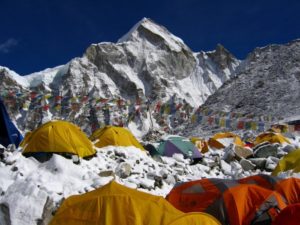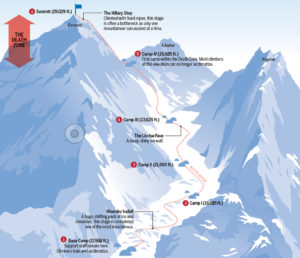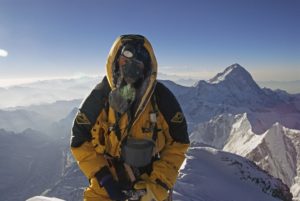Mt Everest is the tallest mountain on earth. For adventure seekers, it’s the ultimate challenge. What better adventure than to stand on top of the world? This achievement comes at a huge cost, but with the right conditions, physical capability, and bank account balance, it is a feat that is achievable for many.
As far as difficulty goes, Everest is technically not that hard for experienced mountaineers. While it’s certainly not easy to climb Everest, there are harder objectives out there. The biggest barriers are money and fitness. It costs quite a lot to climb Everest. To get on an expedition, it’s going to run anywhere from $40,000 to $130,000. However, the climbers live in style. Everest Base Camp has amenities such as wifi, gourmet chef’s, game rooms, a full medical staff, and hot showers.

Being in shape is also a huge factor. Everest sits at an Elevation of 29,029 Feet or 8,848 Meters. The oxygen level in the air at the top of Everest is around 33% of sea level. It takes some serious fitness to be able to keep marching up the peak with such a significant loss of oxygen, with or without supplemental tanks. Everest Base Camp itself has about 50% of the oxygen at sea level. So, before climbers even get started on the climb they only have half of the oxygen they are used to.
The route itself, while being easier than other mountains in the area such as K2 or Annapurna, is not without hardship. The main danger that climbers face is right out of basecamp; The Khumbu icefall. This section of the route is notorious for frequently shifting and moving, creating or shifting huge holes or crevices in the ice. The icefall is also one of the main avalanche paths for the mountain. It is possible that a change in the structure of the icefall could occur when climbers are crossing it, potentially trapping them in a crevice or sending an avalanche in their direction.

Because of Everest’s high elevation, climbing this mountain has its own set of rules. Climbers may need to nearly climb the mountain twice in order to acclimate. There are all kinds of risks involved with climbing the worlds tallest peak. Among these risks are avalanches, heart attacks, unexpected changes in weather, and extreme cold. But the one that’s on all climbers minds is Acute Mountain Sickness or altitude sickness. To mitigate the risk and give the body time to adjust, climbers will spend a night at Camp 1 before moving on. Upon arriving at 21,000 ft, Camp 2 they will spend a couple of days to acclimate before heading back down to Base Camp. While at the high camps the climbers still have access to amenities such as hot food!
As soon as the weather window hits, it’s time to go. Climbers will make there way back through the Khumbu icefall to camp 1, 2, and spend the night at camp 3. From here, climbers will strap an oxygen tank to there back and continue up to 26,247 feet where they enter the Death Zone. The Death Zone is the elevation in which the human body can no longer acclimatize. Cell division stops here and the human body is no longer able to repair itself. At this point, the climb gets very hazardous and it is best to minimize the amount of time spent above this elevation. From Camp 3 Climbers will make there way to camp 4 where they will spend one night. Even with bottled oxygen, the effects of the altitude are still very apparent. It is extremely difficult to eat or sleep. The next day, Climbers will make the push to the summit of Everest. Once they have achieved the feat of standing on the highest point in the world, climbers snap that sweet summit selfie, munch that summit snickers, and descend back to base camp as soon as possible.

Climbing Everest would be impossible without the help of Sherpa. Sherpa are local Nepalese people that grew up around the Himalayan regions of Nepal. They have lung capacities and genes that make them far superior at high elevation in comparison to the western climber. These people are employed by guide services in the region to set up fixed ropes, camps, and other crucial measures before the climbers even get to base camp. The Sherpa are often taking huge risks to ensure the safety of the climbers every year at base camp. The Sherpa may likely have the most dangerous job in the world. Yet, they are paid a fairly low wage to accomplish these tasks.
If you would like to assist the sherpa in making Everest a safer job, consider donating to the Khumbu Climbing Center